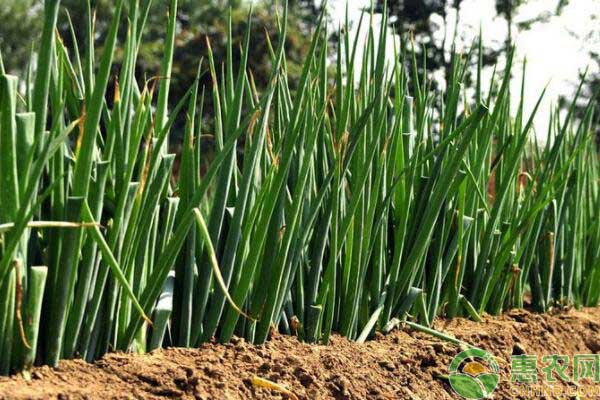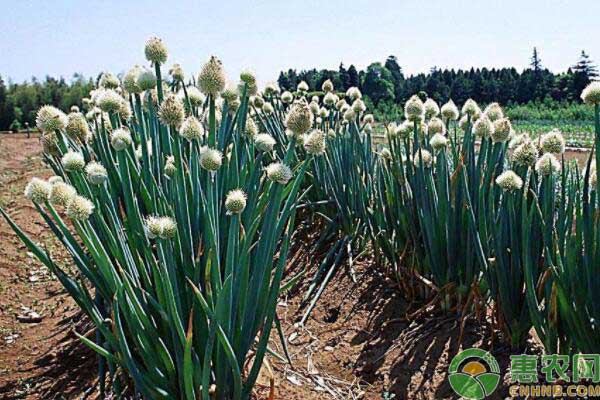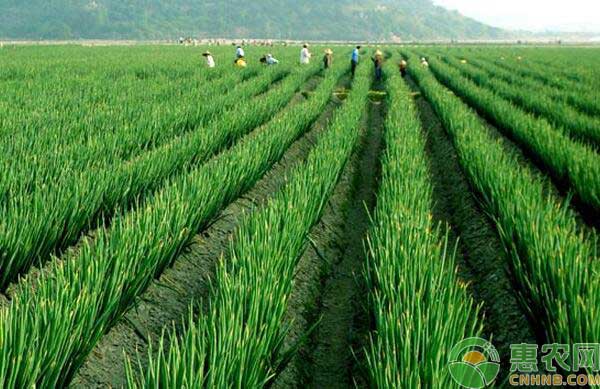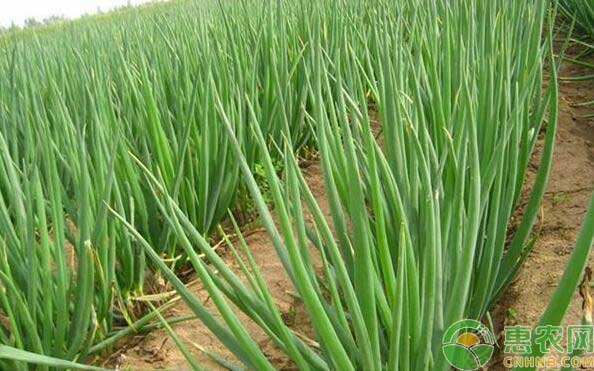How to grow green onions to produce high yields is something that every green onion grower wants to know. In fact, as long as the scientific methods are mastered, it is not a dream to plant high onions. Today, Hui Nong.com will tell you about the high-yield cultivation management techniques of green onions. First, the variety selection Choose varieties suitable for local planting, strong disease resistance, long onion type, high yield and good quality, such as Hanqing, Chinese green onion, Wuyeqi and so on. Second, sowing seedlings Seeding period The sowing is mainly carried out in autumn, usually planted in late September, the seeding rate of 667 m is 1.5~2.0 kg, and the transplanting can be 0.20~0.27 hm. The seedling age is generally controlled at 40~50 days before wintering, and the strong seedling standard is 2~3 true leaves, the plant height is about 10 cm, and the leaf sheath diameter is less than 0.4 cm. 2. Planting on the ground Big onions avoid continuous cropping. When preparing the land, it should be deep-turned to the ground. 667 m of fermented organic fertilizer 1 000 kg, ternary compound fertilizer 30 kg, and biological bacterial fertilizer 30 kg, evenly spread, till the depth of the soil, to achieve the virtual reality. Make a flat raft with a width of 1.1~1.2 m, spread or broadcast, and spread the seeds evenly when spreading. Cover the soil to bury the seeds, and the thickness is 2~3 cm. During the sowing, press the line spacing of 10~12 cm, open the ditch of 2~3 cm, spread the seeds in the ditch, and cover the seeds with the flattening. 3. Seedling management Combine cultivating with seedlings until the seedlings return to green, timely remove the weeds and timely time seedlings; after returning to green, watering and topdressing should be done once or twice. As the temperature rises, the growth will increase, the number of irrigations and the amount of irrigation will be increased, and the seedbed will be kept dry. After 5 months, pay attention to water control, stop watering 10 days before planting, and carry out seedling exercise. Third, colonization During the planting period, the planting period of the onion is generally from late May to June. The planting seedlings are about 40 cm in height and the diameter is more than 1 cm. It is better to plant early. Planting too late, the onion formation period is short, the yield is low, and the seedlings tend to be prolonged, the weather is hot after planting, and it is not easy to slow down the seedlings. Ditching The green onions are heavy and weak, with many pests and diseases, and low yield. It is best to carry out 3~4 a rotations. 667 m organic fertilizer 5 000 kg, diammonium phosphate 50 kg, potassium sulfate 30 kg, biological bacterial fertilizer 50 kg deep tillage, after leveling and ditching and ditching the soil at the bottom of the ditch. The distance between the long scallion and the white onion is 80~90 cm, the distance between the short onion and white is 50~60 cm, the depth of the groove is about 30 cm, and the width of the groove is 20~30 cm. 2. Colonization method The method of planting onions is mainly based on the method of placing onions. When planting, first use a hoe to draw a fixed ditch at the bottom of the ditch, and plant it according to the size of the seedlings. Place the leaf fan on the side of the ditch wall at a distance of 3~5 cm. If it is east and west, it will be placed on the south side. The ditch is placed on the west side. After the swing, use the hoe to bury the roots of the seedlings from the other side, 7~10 cm thick, and step on the ground to prevent the seedlings from being washed down. And the seedling water is filled in the ditch, the water volume is small, and the soil is covered after the irrigation. After 3~5 days, choose a sunny day to fill the seedling water, and then cultivate the seedlings. According to the variety, soil fertility and seedling size, the planting density is reasonably densely planted to achieve high yield. The principle of planting is that the seedlings are slightly thin, the seedlings are slightly dense, the ground is densely planted, and the ground is thin and thin. Generally, the stalks of stalks of 667 m are planted from 16,000 to 18,000, and the stalks of 667 m are suitable for planting 18,000 to 20,000. Fourth, field management Topdressing and watering After 4~5 days of planting, the onion seedlings began to sprout new roots. The amount of irrigation in the early stage should be less, and the irrigation amount should be sufficient in the middle and late stages. Before the beginning of autumn, follow the rules of seeing the sky, seeing the land, and seeing the growth, and discretionary irrigation. After the autumn, combined with irrigation to carry out topdressing, 667 m of ternary compound fertilizer 15 kg and soil. Before and after the summer, watering masters the principle of light pouring and pouring in the morning and evening. In combination with the watering of 667 m, 15 kg of urea was applied. After the application, the ridge was broken and the onion ditch was filled. After September, the temperature difference between day and night increased, and it entered a long period of scallions, and an average of 7 to 8 days grew a new leaf. This period is a key period for the management of fertilizer and water. The irrigation is mastered and poured. Topdressing is mainly based on quick-acting nitrogen fertilizer, with 667 m topdressing urea 15 kg and potassium sulfate 10 kg. 2. Soil The soil should be dried in the morning after the dew is dry, and the soil is cool and the water content is appropriate. After the green onion is slowed down, the soil is mixed with topdressing and irrigation for 15 days. When the first two times of soil cultivation, the plant grows slowly and the soil should be shallow. When the soil is cultivated for the third time, the plant grows rapidly and the soil should be thicker. It is advisable not to bury the heart leaves every time. V. Harvest Generally, when the growth of the outer leaves is basically stopped, the color of the leaves turns yellowish green, and the soil is harvested before freezing. At the time of harvest, the side of the onion ridge can be dug deep, and the onion is exposed. The onion strain can be pulled out by hand, and it can be bundled into a bundle of about 10 kg after drying. Sixth, pest control Purple spot disease with 64% anti-virus WP WP 500 times, 72% ke WP 800 times solution; virus disease 20% virus A WP 500 times solution, 40% kebao treasure soluble powder 1 000 times; Mold disease with 60% Baitai water dispersion granules 800 times, 25% metalaxyl WP 750 times; rust with 10% Shigao water dispersion granules 1500 times, 75% chlorothalonil WP 600 times; Liriomyza sativae is 800 times with 1.8% avermectin EC, 1000% for 40% green tea emulsifiable concentrate; 1000 times for 50% phoxim emulsifiable concentrate for onion fly, 1500 times for 48% lesbian emulsifiable concentrate; 5% for beet armyworm Pushen Suspension 1 500 times, 1.8% avermectin EC 800 times; Hummer with 10% imidacloprid WP 1000 times, 2.5% Uranus EC 1500 times. The above is the high-yield cultivation management technology of the green onion that you have compiled for you. I hope to help you grow green onions.
Hologram Labels & Stickers which symbolizes the originality of a brand.
The hologram labels can be in different thickness inclue 25#,36#,50# or 80gsm/150gsm as customized. The purpose of using a hologram is for Anti-counterfeit and Brand protection.
Hologram labels,Hologram labels for food,Hologram labels for fruits,2D laser labels,3D laser labels Wenzhou Haoshi Light Industrial Products Co., LTD , https://www.economicseals.com



The hologram labels are produced by using premium grade materials and advanced printing techniques. The hologram labels has appealing appearance and offer security protection to the brand.
The Hologram labels are provided with unique identity eradicating the possibility of duplicity and imitation of the novel brand.
We produce the Hologram labels and stickers in customized designs, shapes, colors and patterns according to the requirements of our customers.
High-yield cultivation management technology of green onion
Next Article
Production and management of laying hens
Prev Article
Pesticide auxiliaries: Aid to help pesticides